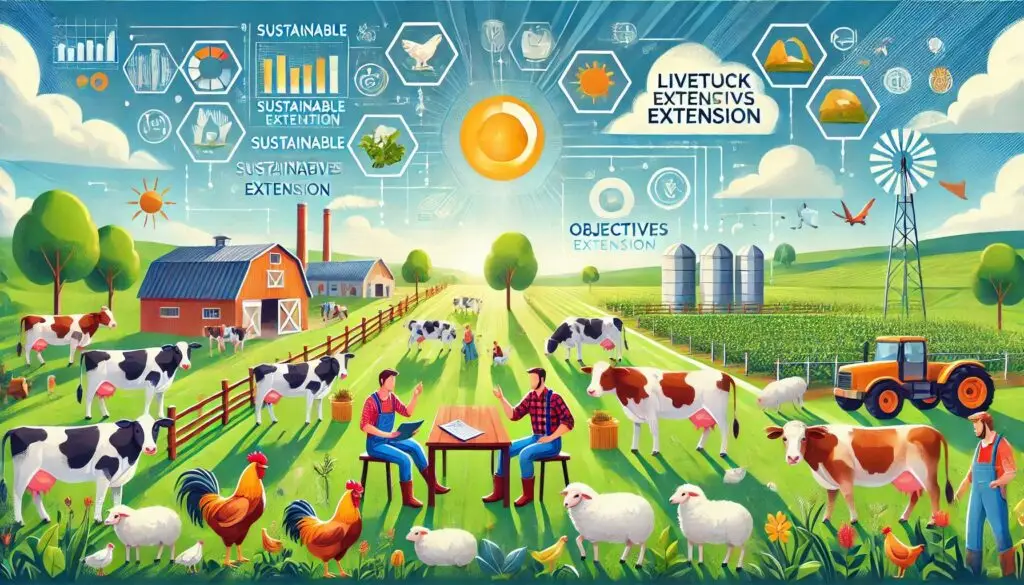Principles of Extension in Livestock-Centric Agriculture

Introduction
Extension services play a vital role in livestock-centric agriculture. They help farmers improve their practices and increase productivity. This article explores the principles of extension in livestock farming, emphasizing effective communication, community involvement, and sustainable practices.
Understanding Livestock Extension
Livestock extension refers to the systematic communication with livestock owners. The goal is to enhance their knowledge and skills. According to the FAO, effective extension services lead to better decision-making among farmers. This ultimately raises their standard of living and increases animal production.
Importance of Livestock Extension
Livestock farming is crucial for food security and economic stability. It provides livelihoods for millions worldwide. However, many farmers lack access to essential resources and knowledge. Extension services bridge this gap by providing necessary information and support.
Key Principles of Livestock Extension
1. Principle of Needs and Interests
Extension programs must cater to the specific needs of livestock owners. Understanding local challenges helps tailor educational interventions effectively. The ICAR emphasizes that programs should focus on issues relevant to farmers.
2. Principle of Cultural Sensitivity
Recognizing cultural differences is vital for successful extension work. Each community has unique customs and values. Extension workers should respect these aspects to foster acceptance of new practices.
3. Principle of Participation
Active participation from farmers enhances learning outcomes. Engaging them in problem identification and solution development fosters ownership and commitment to new practices.
4. Adaptability Principle
Extension programs should be flexible to adapt to changing circumstances. Local conditions vary significantly; thus, programs must be adjustable to remain relevant.
5. Grassroots Organization Principle
Organizing extension efforts at the grassroots level ensures community involvement in program planning and execution. This enhances local leadership and strengthens community ties.
6. Leadership Development
Developing local leaders within communities can amplify the impact of extension services. These leaders often have better credibility with their peers, making them effective advocates for change.
7. Whole-Family Approach
Engaging the entire family unit in extension activities maximizes impact. When all members understand new practices, adoption rates increase.
8. Cooperation Principle
Extension work thrives on cooperation among various stakeholders, including farmers, extension agents, and local organizations. Collaborative efforts lead to more significant benefits for the community.
9. Satisfaction Principle
The ultimate goal of extension services is farmer satisfaction through improved practices that enhance productivity and income.
10. Evaluation Principle
Continuous evaluation is crucial for measuring the effectiveness of extension activities. Regular feedback helps refine programs for better outcomes.
Challenges in Livestock Extension
Despite its importance, livestock extension faces several challenges:
- Limited access to resources
- Insufficient training for extension workers
- Poor infrastructure in rural areas
- Resistance from farmers due to past experiences with ineffective programs
According to a study published in PMC, many farmers are willing to pay for quality extension services if they are available.
Strategies for Effective Livestock Extension
To overcome these challenges, several strategies can be implemented:
Training Programs for Extension Workers
Providing comprehensive training for extension workers ensures they are well-equipped with knowledge about current best practices in livestock management.
Community Engagement Initiatives
Encouraging community participation through workshops and meetings can foster a sense of ownership among farmers regarding their agricultural practices.
Use of Technology
Leveraging technology can improve access to information and resources for farmers. Mobile applications and online platforms can facilitate communication between farmers and extension agents.
Collaboration with NGOs
Partnering with non-governmental organizations (NGOs) can enhance resource availability and provide additional support for farmers.
Conclusion
The principles of livestock extension are essential for improving agricultural practices among livestock owners. By focusing on needs, cultural sensitivity, participation, adaptability, grassroots organization, leadership development, family involvement, cooperation, satisfaction, and evaluation, extension services can significantly enhance livestock production.
More From Extension Education:
Aims of Agricultural Extension





Responses